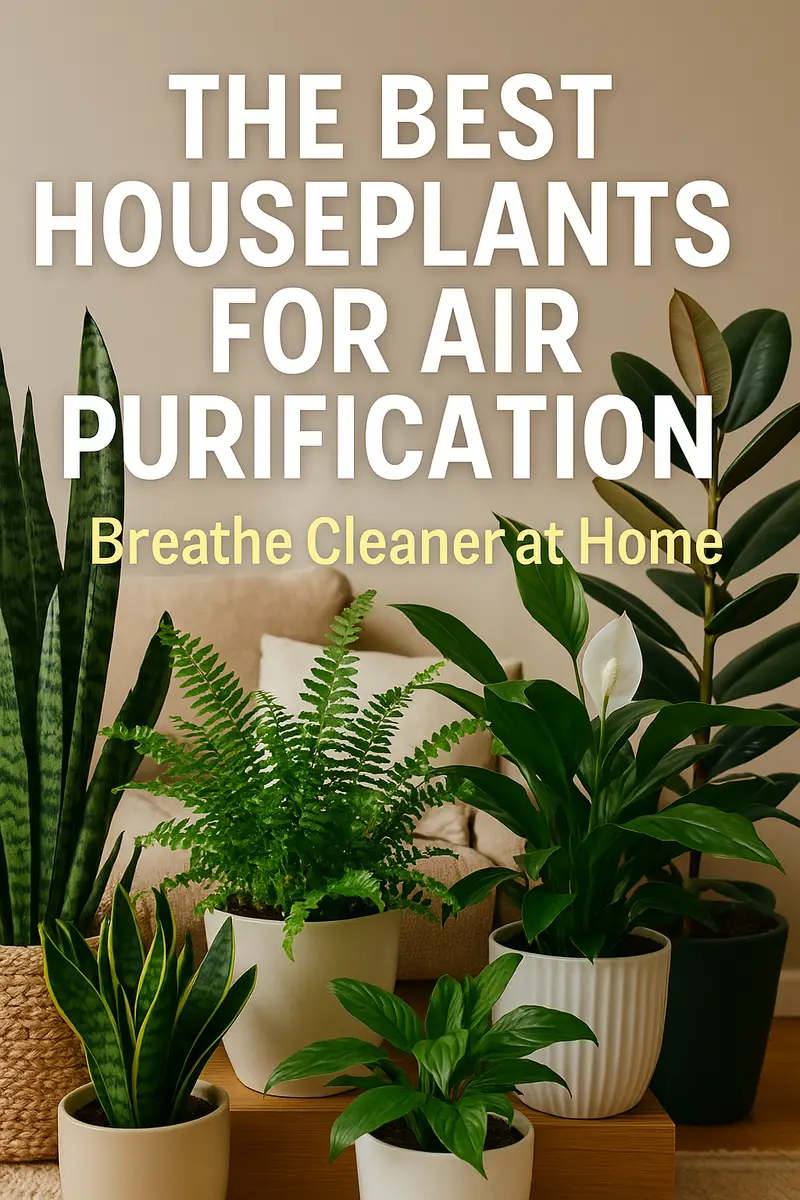The Best Houseplants for Air Purification: Breathe Cleaner at Home

Best houseplants for air purification have become essential for modern families dealing with poor indoor air quality. After years of battling dust, allergens, and mystery chemicals floating through our homes, I’ve discovered that the greenest solutions often work best.
Indoor air can be 2-5 times more polluted than outdoor air, according to the Environmental Protection Agency. Common household items release volatile organic compounds that build up in our sealed, energy-efficient homes. Without proper ventilation, these toxins circulate endlessly through our living spaces.
The NASA Clean Air Study revolutionized our understanding of how plants clean indoor air. Researchers identified specific houseplants that remove up to 87% of air toxins within 24 hours while boosting oxygen levels and increasing humidity naturally.
Why Your Family Needs the Best Houseplants for Air Purification
🌿 Your home’s air quality affects everything. From sleep quality to respiratory health, the air we breathe indoors directly impacts our family’s well-being. Children and elderly family members are particularly sensitive to indoor air pollutants.
Modern homes trap chemicals from cleaning products, furniture off-gassing, carpet adhesives, and electronic equipment. These volatile organic compounds accumulate over time, creating invisible health challenges that many families don’t even realize they’re facing.
💡 Plants offer proven, natural air cleaning power. The best houseplants for air purification don’t just look pretty—they work around the clock to filter harmful chemicals while releasing fresh oxygen. This natural approach costs less than mechanical air purifiers and provides additional mental health benefits.
Research consistently shows that caring for plants reduces stress hormones, improves focus, and creates calming environments. It’s like having a natural therapy session every time you tend to your green family members.
Top Picks: The Best Houseplants for Air Purification
1. Snake Plant (Sansevieria trifasciata) – The Night Shift Champion

✅ Why snake plants earn top spots among the best houseplants for air purification: These architectural beauties filter benzene, formaldehyde, trichloroethylene, and xylene from indoor air while requiring minimal care.
The magic happens after dark when most plants take a break. Snake plants continue working through the night, releasing fresh oxygen while you sleep. This makes them perfect bedroom companions for better rest and cleaner air.
Care requirements simplified: Water every 2-3 weeks, tolerates low light conditions, and survives temperature fluctuations that would stress other plants. Perfect for beginners who want maximum air purification with minimal time investment.
For more tips on creating healthier living spaces, check out our guide on 8 Simple Ways to Create a Healthier Home for Your Family.
Pro tip: Place one snake plant per 100 square feet for optimal air cleaning results. Their upright growth habit makes them ideal for corners and narrow spaces where other plants won’t fit.
2. Peace Lily (Spathiphyllum) – The Humidity Hero
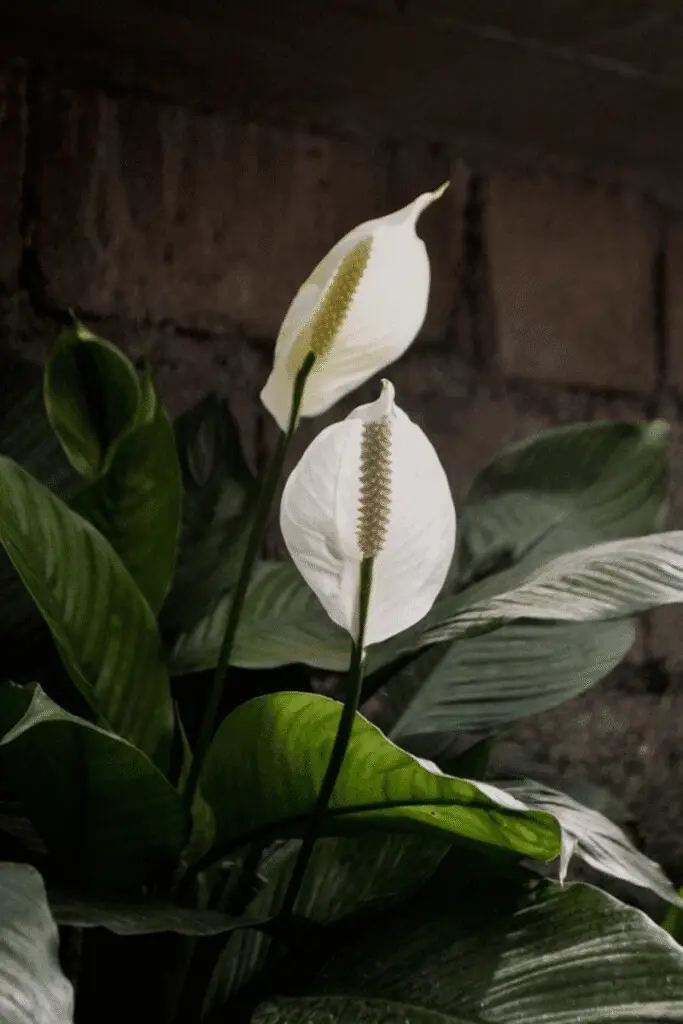
🌸 Peace lilies rank among the best houseplants for air purification because they tackle multiple toxins while adding crucial moisture to dry indoor environments. They remove benzene, formaldehyde, and carbon monoxide while producing stunning white blooms.
These communicative plants tell you exactly what they need—droopy leaves signal thirst, and they perk up quickly after proper watering. The elegant flowers add sophisticated beauty while working overtime to clean your family’s air.
Important safety note: Keep peace lilies away from pets and small children, as they’re toxic if ingested according to the ASPCA. Position them on high shelves or in rooms where curious paws and hands can’t reach.
Optimal placement: Bathrooms and bedrooms benefit most from peace lilies’ humidity-boosting properties, especially during dry winter months when heating systems zap moisture from indoor air.
3. Areca Palm (Dypsis lutescens) – The Pet-Safe Powerhouse
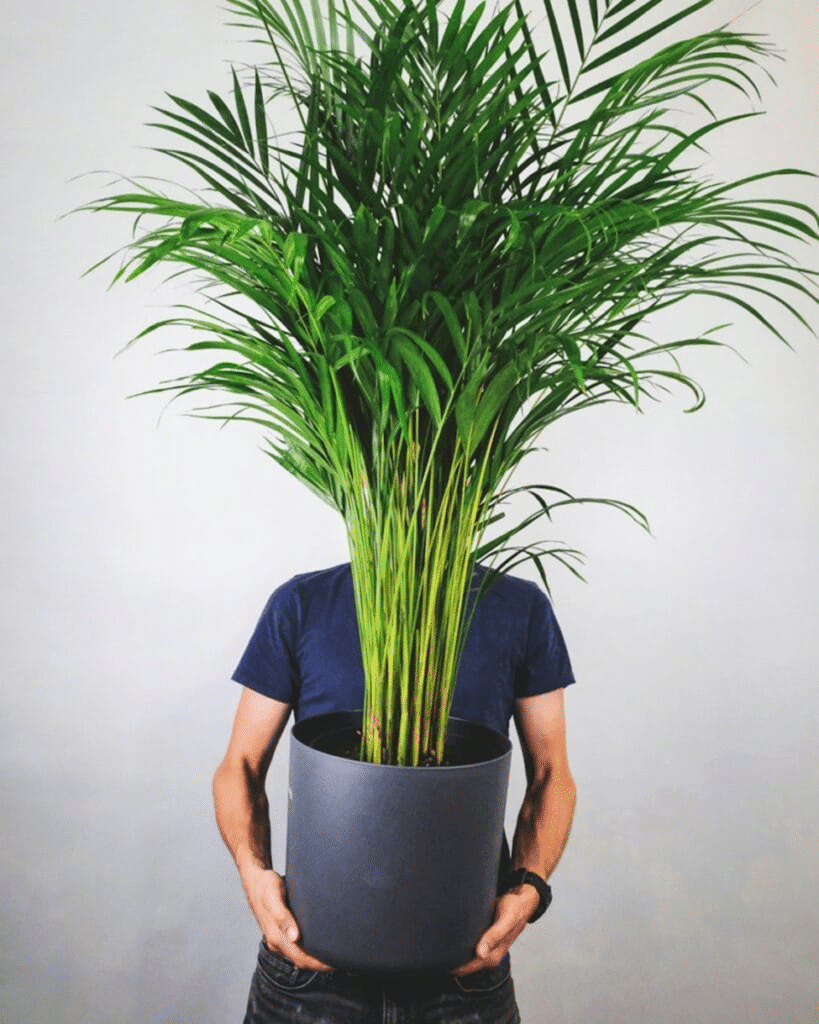
🌴 Areca palms deserve recognition among the best houseplants for air purification for families with pets. These graceful palms remove airborne toxins while pumping moisture into dry indoor environments without posing risks to curious cats and dogs.
These tropical beauties filter chemicals from cleaning products, paint fumes, and furniture off-gassing while creating stunning focal points in living rooms or home offices. They grow relatively quickly and can become impressive statement pieces.
Family-friendly benefits: Completely non-toxic to pets and children, making them perfect for households where safety concerns limit plant choices. Their large fronds provide maximum surface area for air filtration.
Growth expectations: Areca palms can reach 6-8 feet indoors with proper care, providing substantial air cleaning capacity as they mature. Start with smaller plants and enjoy watching them develop into natural air purification systems.
4. Boston Fern (Nephrolepis exaltata) – The Formaldehyde Fighter
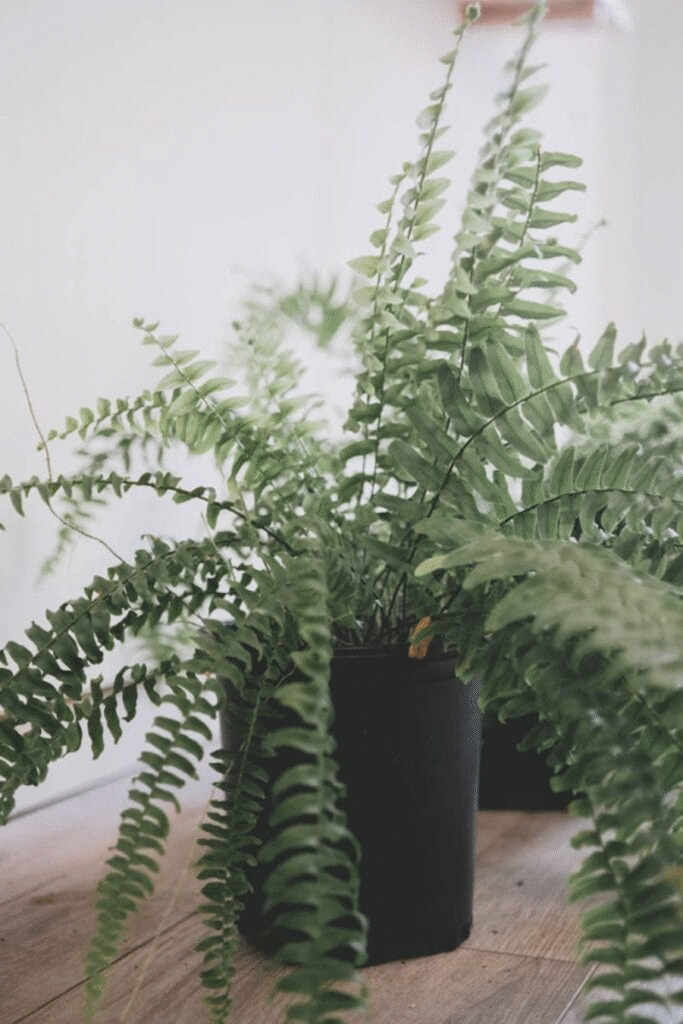
📌 Boston ferns excel among the best houseplants for air purification when targeting specific indoor pollutants like formaldehyde and xylene. These lush, feathery plants thrive in indirect light while boosting humidity levels significantly.
Formaldehyde lurks in pressed wood furniture, carpeting, and household cleaning products. Boston ferns work continuously to remove this common toxin while adding old-school charm to modern homes.
Humidity requirements: These ferns love moisture and appreciate regular misting or placement on pebble trays filled with water. They’re particularly effective in bathrooms where natural humidity supports their growth and air-cleaning abilities.
Display options: Hanging baskets showcase Boston ferns beautifully while positioning them at optimal heights for air circulation. Their cascading fronds create living curtains that filter air while adding natural texture to room designs.
5. Rubber Plant (Ficus elastica) – The Low-Maintenance Legend
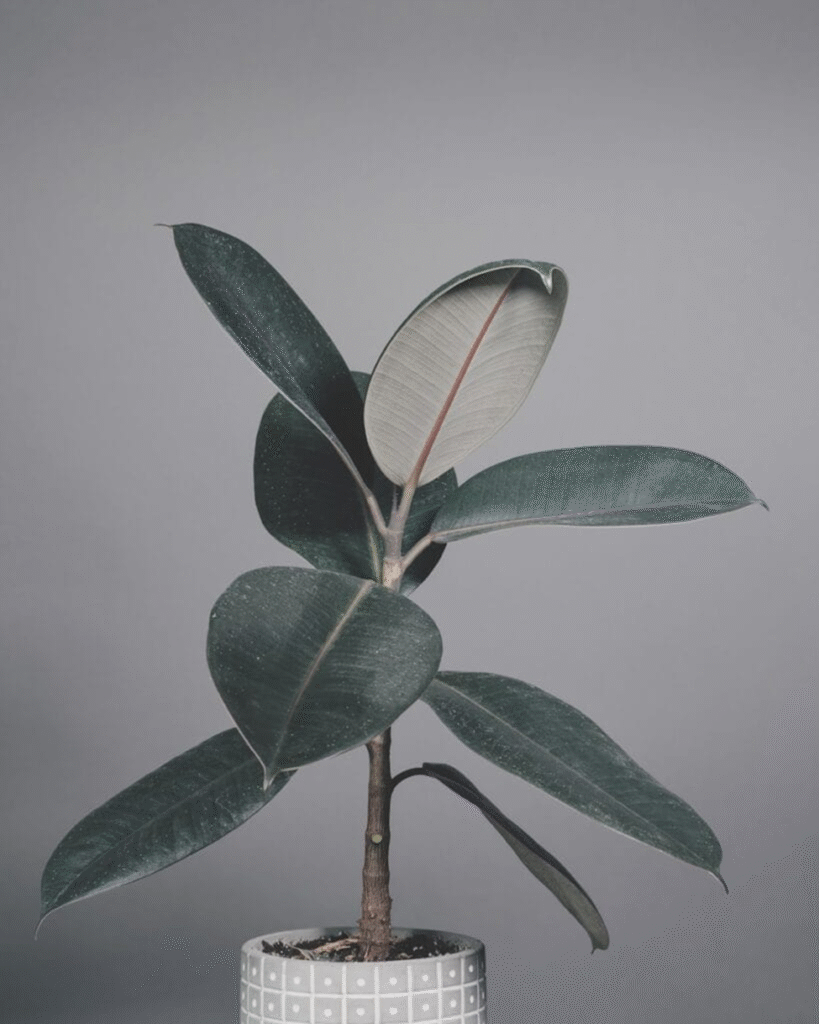
🔍 Rubber plants earn spots among the best houseplants for air purification through their exceptional ability to remove formaldehyde and carbon monoxide from indoor spaces. Their thick, glossy leaves efficiently process pollutants while requiring minimal daily attention.
These adaptable plants thrive in various light conditions and can grow into impressive statement pieces over time. They’re particularly valuable in home offices where they combat chemicals from electronics, printers, and office furniture.
Growth potential: Rubber plants can develop into substantial indoor trees with proper care, providing increased air filtration capacity as they mature. Their architectural form complements modern and traditional décor styles.
Pet consideration: Mildly toxic to cats and dogs, so strategic placement away from pet areas is essential for families with animals.
Pet-Safe Champions: Best Houseplants for Air Purification
Spider Plant (Chlorophytum comosum) – The Beginner’s Dream

🕷️ Spider plants rank among the best houseplants for air purification for pet-owning families because they’re completely safe while removing carbon monoxide and formaldehyde effectively. They’re virtually indestructible and produce baby plants for easy propagation.
These cheerful plants thrive in bright, indirect light and forgive occasional neglect. Their cascading babies create beautiful displays in hanging baskets while multiplying your air-cleaning capacity naturally.
Propagation bonus: Each mature spider plant produces multiple offspring that you can root in water and plant separately. This turns one purchase into an entire collection of air-purifying plants.
Placement strategy: Hang spider plants near windows where their babies can cascade freely while filtering air at multiple levels throughout your rooms.
Calathea (Prayer Plant) – The Pattern Master
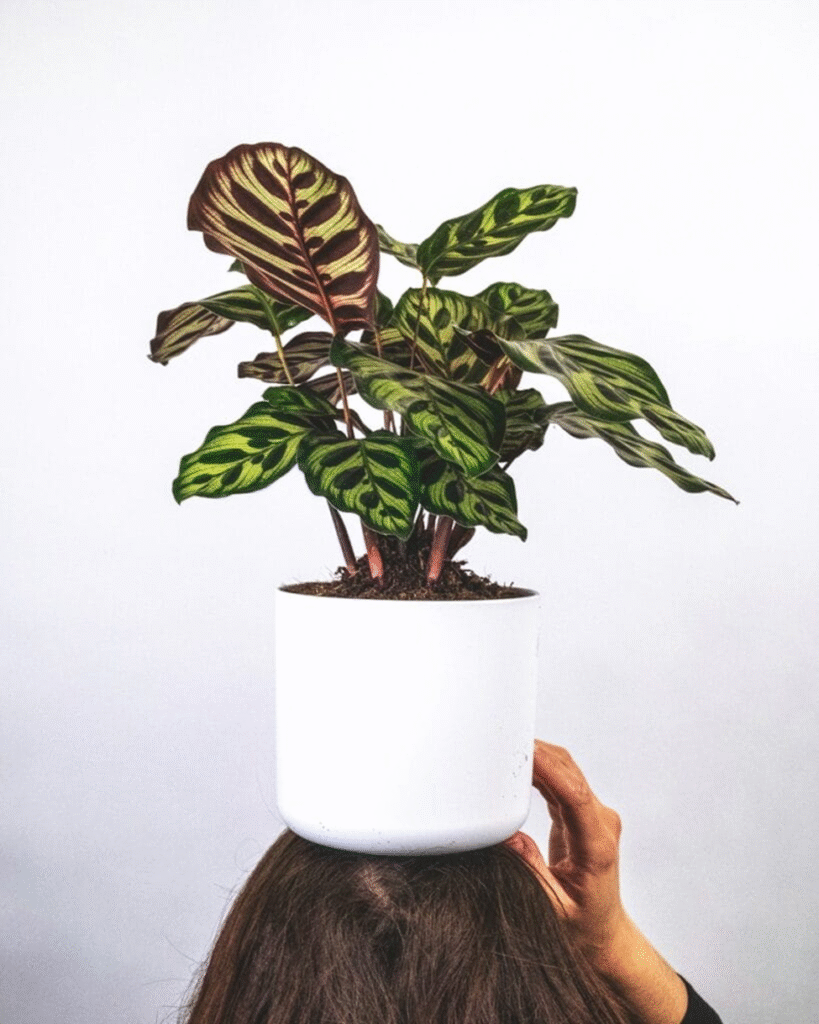
🍃 Calatheas deserve consideration among the best houseplants for air purification for their pet-safe properties and stunning leaf patterns. These plants add oxygen to your home while creating gorgeous visual interest through their intricate foliage designs.
Prayer plants fold their leaves at night, creating dynamic displays that change throughout the day. They prefer humid environments and indirect light, making them ideal for bathrooms or kitchens with adequate moisture.
Care specifics: Calatheas communicate their needs through leaf movement—curled edges typically indicate insufficient humidity. Use pebble trays or humidifiers to maintain optimal growing conditions.
Variety options: Multiple Calathea species offer different leaf patterns and sizes, allowing you to create diverse collections while maintaining pet safety standards.
Parlor Palm (Chamaedorea elegans) – The Compact Cleaner

🌿 Parlor palms qualify among the best houseplants for air purification for smaller spaces and pet-friendly households. These compact palms remove indoor toxins while staying manageable in apartments or rooms with limited space.
These palms tolerate low light conditions better than many tropical plants and require minimal watering schedules. They’re completely non-toxic to pets while adding tropical elegance to any room design.
Space efficiency: Parlor palms provide maximum air cleaning in minimal floor space, making them perfect for apartments, condos, or rooms where larger plants won’t fit comfortably.
Longevity: With proper care, parlor palms can live for decades indoors, providing long-term air purification value for your investment.
Maximizing Air Purification: Strategic Plant Placement
The NASA Formula for Success
👉 One plant per 100 square feet represents the research-backed recommendation for effective air purification using the best houseplants for air purification. This means typical bedrooms need 1-2 plants, while larger living areas benefit from 3-4 strategically positioned plants.
Different plants target different toxins, so variety trumps quantity in creating comprehensive air-cleaning systems. Pairing snake plants with Boston ferns creates round-the-clock toxin removal that addresses multiple indoor air quality concerns.
Room-specific strategies work best: Bedrooms benefit from oxygen-producing plants like snake plants and aloe vera. Living rooms can accommodate larger statement plants like rubber trees or areca palms that process more air volume.
Kitchen considerations: Choose plants that tolerate temperature fluctuations and higher humidity levels. Spider plants, Boston ferns, and peace lilies thrive in kitchen environments while filtering cooking-related pollutants.
Light Requirements and Optimal Positioning
✅ Most of the best houseplants for air purification prefer bright, indirect light for optimal toxin processing capabilities. Direct sunlight can scorch sensitive leaves, while insufficient light reduces their ability to filter chemicals effectively.
South-facing windows with sheer curtains provide ideal growing conditions for most air-purifying plants. North-facing windows work well for low-light tolerant options like snake plants and ZZ plants.
Artificial light solutions: LED grow lights can supplement natural lighting in darker homes, ensuring your air-purifying plants maintain peak performance year-round. Position lights 12-18 inches above plant canopies for best results.
Rotation benefits: Rotate plants weekly to ensure even light exposure and prevent lopsided growth that could reduce air filtration efficiency.
Plant Care Essentials for Maximum Air Cleaning
Proper Watering Techniques
🚨 Overwatering kills more of the best houseplants for air purification than any other care mistake. Soggy soil creates perfect conditions for root rot and mold growth, completely eliminating air-cleaning benefits while potentially worsening indoor air quality.
Check soil moisture by inserting your finger about one inch deep into the potting mix. If it feels dry, it’s time to water thoroughly. If moisture remains, wait several more days before checking again.
Drainage is non-negotiable: Every pot must have drainage holes to prevent water accumulation around plant roots. Use well-draining potting soil formulated for houseplants rather than heavy garden soil that retains too much moisture.
Water quality matters: Chlorinated tap water can stress sensitive plants over time. Let tap water sit overnight to allow chlorine to evaporate, or use filtered water for optimal plant health and air purification performance.
Speaking of creating chemical-free environments, you might also enjoy our Chemical-Free Cleaning Kit: A Comprehensive Building Guide for a completely natural home approach.
Cleaning and Maintenance for Peak Performance
💡 Clean leaves are essential for the best houseplants for air purification to function at peak efficiency. Dust accumulation blocks pores that plants use to absorb airborne toxins, dramatically reducing their air-cleaning capabilities.
Wipe leaves weekly with damp, soft cloths to remove dust and restore their natural shine. This simple maintenance step can improve air purification by up to 50% compared to neglected, dusty plants.
Pruning promotes health: Remove dead, yellowing, or damaged leaves promptly to redirect plant energy toward new growth and continued air filtration. Use clean, sharp scissors to prevent disease transmission.
Repotting schedules: Most houseplants need fresh soil every 1-2 years to maintain optimal root health and air purification performance. Spring is typically the best time for repotting projects.
Common Mistakes That Reduce Air Purification
Choosing Plants That Don’t Match Your Lifestyle
🔍 The best houseplants for air purification are worthless if they die from neglect. High-maintenance plants in busy households often struggle or perish, eliminating their air-cleaning benefits entirely.
Be realistic about your available time and energy for plant care. If you travel frequently or have unpredictable schedules, focus on drought-tolerant options like snake plants, ZZ plants, or rubber trees that forgive occasional neglect.
Start small and expand gradually: Begin with 2-3 proven performers rather than overwhelming yourself with a jungle of high-maintenance varieties. Success with easy plants builds confidence for more challenging species later.
Match plants to rooms: Consider each room’s specific conditions when selecting the best houseplants for air purification. Bathrooms need humidity-loving plants, while offices benefit from low-light tolerant varieties.
For comprehensive home health strategies, explore our Healthy Home Tips: Creating a Cleaner, Happier Space guide.
Ignoring Pet and Child Safety
❤️ Many of the best houseplants for air purification can be toxic if ingested by curious pets or small children. Research every plant’s safety profile before bringing it into your home to prevent unnecessary risks.
Safe alternatives exist for every toxic plant variety. Instead of peace lilies, choose parlor palms. Swap rubber plants for spider plants. You never have to sacrifice air quality for family safety with proper plant selection.
For more family safety insights, read our 7 Home Safety Tips Every Parent Needs: A Veteran Dad’s Guide.
Strategic placement helps: Even mildly toxic plants can work in homes with pets and children when positioned out of reach on high shelves, hanging baskets, or rooms with restricted access.
Emergency preparedness: Keep contact information for poison control and your veterinarian easily accessible, and learn to identify signs of plant poisoning in both humans and animals.
Expecting Instant Results
📌 The best houseplants for air purification need time to establish and reach peak performance in their new environments. While some air-cleaning effects begin immediately, optimal toxin removal develops over several weeks as plants adjust to your home’s conditions.
Be patient with new plant acquisitions during their adjustment period. Consistent care during the first month helps establish strong root systems that support long-term air purification capabilities.
Realistic expectations: One small plant won’t transform your home’s air quality overnight. Building effective air purification requires multiple plants working together over time to create meaningful improvements.
Measurement challenges: Air quality improvements may not be immediately noticeable to human senses, but sensitive individuals often report reduced allergy symptoms and better sleep quality within weeks of adding plants.
The Science Behind Natural Air Purification
How Plants Process Indoor Toxins
🧠 The best houseplants for air purification use three-part systems to remove harmful chemicals from indoor environments. Leaves capture airborne pollutants, roots process toxins dissolved in water, and beneficial soil bacteria break down organic compounds.
This natural process happens continuously through photosynthesis and plant respiration. Plants literally breathe in contaminated air and exhale clean oxygen back into your living spaces.
Microorganism partnerships: Beneficial bacteria in potting soil play crucial roles in processing toxins that plants absorb through their root systems. Healthy soil ecosystems enhance overall air purification performance.
Night versus day operations: While most air purification happens during daylight hours when photosynthesis is active, some plants like snake plants continue oxygen production at night through different metabolic processes.
Specific Toxin Targeting
✅ Different plants among the best houseplants for air purification specialize in removing specific chemical compounds commonly found in modern homes. Understanding these specializations helps create targeted air-cleaning strategies.
Formaldehyde sources and solutions: This common indoor pollutant comes from pressed wood furniture, carpeting, and cleaning products. Boston ferns, snake plants, and peace lilies excel at formaldehyde removal through specialized leaf structures.
Benzene elimination: Found in plastics, synthetic fabrics, and stored gasoline, benzene requires plants with waxy leaves like rubber plants and snake plants that can process this petroleum-based compound effectively.
Carbon monoxide concerns: While plants can’t replace proper ventilation for dangerous carbon monoxide levels, peace lilies and spider plants help process lower concentrations from everyday sources like gas appliances and attached garages.
Budget-Friendly Strategies for Plant Collections
Starting Smart with Proven Performers
💡 Build your collection of the best houseplants for air purification gradually to spread costs over time while learning proper care techniques. Focus on 2-3 proven varieties that offer maximum air-cleaning benefits with minimal investment.
Propagation multiplies your plant collection without additional purchases. Spider plants, snake plants, and peace lilies all produce offspring that develop into full-sized air purifiers with patience and proper care.
Local resources save money: Plant swaps, community garden sales, and online plant groups often feature experienced gardeners sharing cuttings or trading established plants at fraction of retail costs.
Seasonal shopping strategies: End-of-season clearances at garden centers offer healthy plants at reduced prices. Late fall and early spring typically provide best deals on houseplants.
Growing Your Own Air Purification Army
🌱 Many of the best houseplants for air purification propagate easily from cuttings, division, or plantlets, allowing one purchase to become multiple air-cleaning plants over time.
Water propagation methods: Spider plants, snake plants, and many other varieties root readily in water before transplanting to soil. This free multiplication dramatically expands your air purification capacity.
Division techniques: Established plants like peace lilies and snake plants can be carefully divided during repotting, creating multiple plants from single specimens while refreshing their growing medium.
Sharing and trading: Successful propagation often produces more plants than single households need, creating opportunities to trade with friends and neighbors for different varieties.
Troubleshooting Air Purification Plant Problems
Common Issues and Quick Solutions
🚨 Yellow leaves typically indicate overwatering problems that can kill even the best houseplants for air purification if not addressed promptly. Check soil moisture levels and adjust watering schedules to prevent root rot.
Ensure all containers have adequate drainage holes and use appropriate potting soil that allows excess water to escape. Standing water around roots creates perfect conditions for fungal diseases that eliminate air-cleaning benefits.
Brown leaf tips often signal low humidity or chemical sensitivities common in dry indoor environments. Increase humidity with pebble trays, humidifiers, or plant groupings that create beneficial microclimates.
Pest prevention beats treatment: Regular leaf inspection prevents major infestations that can weaken plants and reduce their air purification capabilities. Early detection makes natural treatment methods more effective.
Environmental Adjustments for Success
✅ Temperature fluctuations stress the best houseplants for air purification and reduce their ability to process indoor toxins effectively. Maintain consistent temperatures between 65-75°F for optimal plant performance.
Avoid placing plants near heating vents, air conditioning units, or drafty windows where temperature swings can shock sensitive root systems and interrupt normal metabolic processes.
Air circulation benefits: Gentle air movement from ceiling fans or open windows helps plants process more air volume while preventing stagnant conditions that promote fungal problems.
Seasonal adjustments: Reduce watering frequency during winter months when lower light levels slow plant growth and reduce water uptake. Resume normal schedules as daylight hours increase in spring.
Creating Comprehensive Air Purification Systems
Room-by-Room Plant Strategies
🏠 Living rooms accommodate larger specimens among the best houseplants for air purification like rubber trees, areca palms, or fiddle leaf figs that can process substantial air volumes while serving as decorative focal points.
Combine different plant heights and textures for maximum visual impact while ensuring complete air filtration coverage. Use plant stands, hanging baskets, and floor plants to create layered systems that clean air at multiple levels.
Bedroom optimization: Choose plants that continue working at night, like snake plants and aloe vera, to maintain air quality during sleep hours when room ventilation typically decreases.
Kitchen and bathroom considerations: These rooms need plants that tolerate higher humidity and temperature fluctuations while filtering cooking odors and bathroom chemicals effectively.
Integration with Home Design
📌 The best houseplants for air purification should enhance your home’s aesthetic while providing functional air-cleaning benefits. Choose decorative containers that complement existing décor while ensuring proper drainage.
Color coordination: Green foliage pairs beautifully with most color schemes, but consider plants with variegated leaves or colorful stems for added visual interest in neutral spaces.
Scale relationships: Consider mature plant sizes when selecting locations to ensure adequate growing space while maintaining balanced room proportions as plants develop.
Lighting integration: Position plants to take advantage of natural light while using them to soften harsh architectural lines or fill empty corners effectively.
The best houseplants for air purification transform homes into healthier, more beautiful living spaces through natural air-cleaning processes that work continuously. Whether starting with single snake plants or developing comprehensive plant collections, every green addition contributes to improved indoor air quality and enhanced family well-being.
Remember that successful plant care develops through consistent attention rather than perfect technique. Start with proven varieties, learn their specific needs, and gradually expand your air-purifying collection as experience and confidence grow. The investment in time and care pays dividends through cleaner air, reduced stress, and the simple satisfaction of nurturing living systems in your home.
Explore More from Our Family of Blogs
Mountains Will Move
Faith-based encouragement for everyday families.
Everyday Exposed
No-filter truth hub for critical thinking and clarity.
Thank you for being part of the community. God Bless you and your family.
